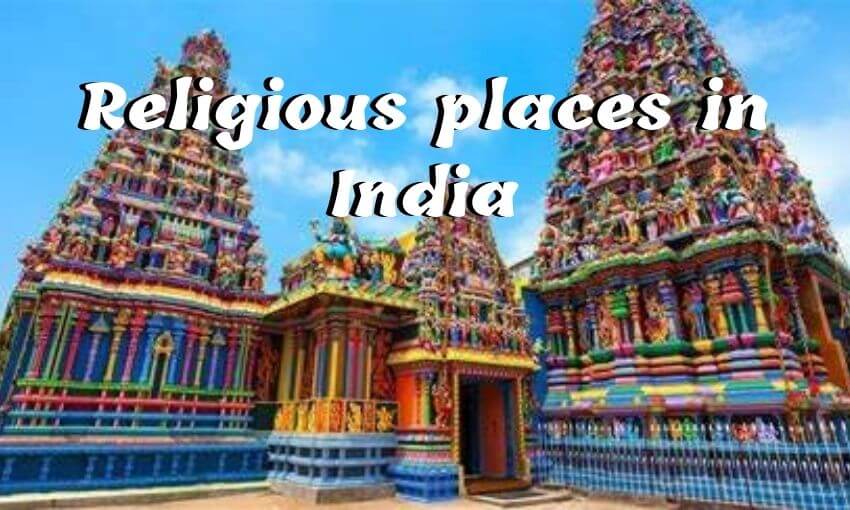India is a land of many religions and cultures, and it is home to some of the most beautiful and sacred religious places in the world. From the majestic Himalayas to the holy rivers of the Ganges and Yamuna, India is a land of spiritual significance. From the ancient temples of the south to the holy shrines of the north, India is a land of religious diversity and spiritual richness. From the ancient caves of Ajanta and Ellora to the majestic Taj Mahal, India is a land of religious monuments and spiritual wonders. From the sacred pilgrimage sites of Varanasi and Haridwar to the holy shrines of Amritsar and Mathura, India is a land of religious devotion and spiritual enlightenment. This article will explore some of the most important religious places in India and their significance.

The Impact of Religion on India’s Architecture: Examining the Influence of Faith on Building Design
India is a country with a rich and diverse history, and its architecture is no exception. From the ancient temples of the Indus Valley Civilization to the modern skyscrapers of Mumbai, India’s architecture has been shaped by its religious beliefs and practices. In this essay, we will explore how religion has impacted India’s architecture, examining the influence of faith on building design.
One of the most obvious ways that religion has impacted India’s architecture is through the construction of temples and other places of worship. From the ancient Hindu temples of the Indus Valley Civilization to the modern mosques of Delhi, religious buildings have been a part of India’s architectural landscape for centuries. These buildings are often ornately decorated and feature intricate carvings and sculptures that reflect the beliefs of the religion they represent.
Religion has also had an influence on the design of residential buildings in India. Many traditional Indian homes feature courtyards and other open spaces that are used for religious ceremonies and rituals. These spaces often feature religious symbols and decorations, such as statues of Hindu gods and goddesses. Additionally, many homes feature small shrines dedicated to particular deities, which are used for daily prayers and offerings.
Finally, religion has also had an impact on the design of public buildings in India. Many government buildings, such as courthouses and government offices, feature religious symbols and decorations. Additionally, many public parks and gardens feature statues of Hindu gods and goddesses, as well as other religious symbols.
In conclusion, religion has had a profound impact on India’s architecture. From the ancient temples of the Indus Valley Civilization to the modern skyscrapers of Mumbai, religious beliefs and practices have shaped the design of buildings in India. From the ornate decorations of religious buildings to the small shrines found in many homes, religion has had a lasting influence on the architecture of India.
Exploring the Rich Cultural Heritage of India’s Religious Places
India is a land of many religions and cultures, and its religious places are a testament to this. From the ancient temples of the Hindus to the grand mosques of the Muslims, India is home to some of the most beautiful and awe-inspiring religious sites in the world. These places are not only important for their religious significance, but also for their rich cultural heritage.
The temples of India are some of the most iconic religious sites in the world. From the majestic Brihadeeswarar Temple in Tamil Nadu to the intricately carved Khajuraho Temples in Madhya Pradesh, these temples are a testament to the skill and artistry of the ancient Indian architects. Not only are these temples a source of spiritual solace, but they also provide a glimpse into the culture and history of India.
The mosques of India are also a source of great cultural heritage. From the grand Jama Masjid in Delhi to the beautiful Taj Mahal in Agra, these mosques are a testament to the beauty and grandeur of Islamic architecture. These mosques are also a reminder of the long history of Muslim rule in India, and the influence of Islamic culture on Indian society.
The churches of India are also a source of great cultural heritage. From the majestic St. Paul’s Cathedral in Kolkata to the beautiful Basilica of Bom Jesus in Goa, these churches are a reminder of the long history of Christianity in India. These churches are also a testament to the influence of Christianity on Indian culture and society.
India is also home to many other religious sites, such as the Buddhist monasteries of Ladakh, the Sikh gurudwaras of Punjab, and the Jain temples of Rajasthan. These places are a reminder of the diversity of religions in India, and the importance of religious tolerance in Indian society.
The religious places of India are a source of great cultural heritage, and they provide a glimpse into the history and culture of India. From the majestic temples of the Hindus to the grand mosques of the Muslims, these places are a reminder of the rich cultural heritage of India.
The History of India’s Ancient Religious Sites: Uncovering the Mysteries of the Past
The ancient religious sites of India are a source of mystery and intrigue, with their secrets hidden deep in the past. From the majestic temples of the Hindu faith to the sacred Buddhist stupas, these sites have been a source of spiritual and cultural enrichment for centuries. But what do we really know about these ancient sites? How did they come to be, and what do they tell us about the history of India? In this article, we will explore the history of India’s ancient religious sites, uncovering the mysteries of the past.
The earliest evidence of religious sites in India dates back to the Indus Valley Civilization, which flourished between 2600 and 1900 BCE. This civilization was home to a number of religious sites, including the Great Bath of Mohenjo-Daro and the Great Stupa of Sanchi. These sites were likely used for religious ceremonies and rituals, and may have been associated with the worship of a variety of gods and goddesses.
The next major period of religious site construction in India was during the Mauryan Empire, which ruled from 322 to 185 BCE. During this period, the emperor Ashoka built a number of Buddhist stupas and monasteries throughout the empire. These sites were used for religious ceremonies and as places of pilgrimage.
The Gupta Empire, which ruled from 320 to 550 CE, was another period of religious site construction in India. During this period, Hindu temples were built throughout the empire, including the famous temples of Khajuraho and Konark. These temples were used for religious ceremonies and as places of pilgrimage.
The next major period of religious site construction in India was during the Mughal Empire, which ruled from 1526 to 1858. During this period, the Mughal emperors built a number of mosques and other religious sites throughout the empire. These sites were used for religious ceremonies and as places of pilgrimage.
Finally, the British Raj, which ruled from 1858 to 1947, was another period of religious site construction in India. During this period, the British built a number of churches and other religious sites throughout the empire. These sites were used for religious ceremonies and as places of pilgrimage.
The history of India’s ancient religious sites is a fascinating one, full of mystery and intrigue. From the earliest evidence of religious sites in the Indus Valley Civilization to the construction of temples, stupas, and mosques during the Mughal Empire, these sites have been a source of spiritual and cultural enrichment for centuries. By uncovering the mysteries of the past, we can gain a better understanding of the history of India and its religious sites.
The Significance of Pilgrimage in India: Exploring the Spiritual Journeys of Devotees
Pilgrimage is an important part of Indian culture and has been for centuries. It is a spiritual journey that devotees take to visit holy sites and seek blessings from the divine. Pilgrimage is a way for people to connect with their faith and to deepen their spiritual understanding. It is also a way for people to come together and share their experiences and beliefs.
The significance of pilgrimage in India is deeply rooted in its spiritual and religious traditions. Hinduism, Buddhism, Jainism, and Sikhism all have their own pilgrimage sites and rituals. For Hindus, the most important pilgrimage sites are the four dhams, or holy places, which are located in the four corners of India. These sites are Badrinath, Dwarka, Puri, and Rameshwaram. Each of these sites is associated with a particular deity and is believed to be a gateway to spiritual enlightenment.
For Buddhists, the most important pilgrimage sites are the four major Buddhist pilgrimage sites, which are located in the four corners of India. These sites are Bodh Gaya, Sarnath, Kushinagar, and Lumbini. These sites are associated with the life of the Buddha and are believed to be places of spiritual awakening.
For Jains, the most important pilgrimage sites are the four major Jain pilgrimage sites, which are located in the four corners of India. These sites are Shatrunjaya, Palitana, Girnar, and Mount Abu. These sites are associated with the life of the Jain Tirthankaras and are believed to be places of spiritual enlightenment.
For Sikhs, the most important pilgrimage sites are the four major Sikh pilgrimage sites, which are located in the four corners of India. These sites are Amritsar, Anandpur Sahib, Patna Sahib, and Hemkund Sahib. These sites are associated with the life of the Sikh Gurus and are believed to be places of spiritual enlightenment.
The significance of pilgrimage in India is not only spiritual but also social. Pilgrimage is a way for people to come together and share their experiences and beliefs. It is also a way for people to connect with their faith and to deepen their spiritual understanding.
Pilgrimage is an important part of Indian culture and has been for centuries. It is a spiritual journey that devotees take to visit holy sites and seek blessings from the divine. Pilgrimage is a way for people to connect with their faith and to deepen their spiritual understanding. It is also a way for people to come together and share their experiences and beliefs. Through pilgrimage, devotees can gain a deeper understanding of their faith and its teachings, and can also gain a greater appreciation for the beauty and diversity of India.
Exploring the Sacred Temples of India: A Guide to the Most Popular Religious Sites
Exploring the sacred temples of India is an experience like no other. From the majestic architecture of the Golden Temple in Amritsar to the intricate carvings of the Meenakshi Temple in Madurai, India’s religious sites are some of the most awe-inspiring places in the world. Whether you’re a spiritual seeker or simply curious about the country’s rich religious history, here’s a guide to some of the most popular temples in India.
The Golden Temple in Amritsar is one of the most iconic religious sites in India. Located in the heart of the city, the temple is a stunning example of Sikh architecture. The temple is made of marble and gold, and its four entrances symbolize the openness of the Sikh faith. Inside, visitors can explore the temple’s many shrines and take part in the daily prayer services.
The Meenakshi Temple in Madurai is another popular religious site. This temple is dedicated to the Hindu goddess Parvati and is known for its intricate carvings and colorful sculptures. The temple complex is made up of 12 gopurams (towers) and is surrounded by a large tank. Visitors can explore the temple’s many shrines and take part in the daily rituals.
The Jagannath Temple in Puri is one of the most important Hindu temples in India. The temple is dedicated to Lord Jagannath, an incarnation of Lord Vishnu. The temple is known for its grand architecture and is home to a number of festivals throughout the year. Visitors can explore the temple’s many shrines and take part in the daily rituals.
The Harmandir Sahib in Amritsar is one of the most important Sikh temples in India. The temple is also known as the Golden Temple and is a symbol of Sikhism. The temple is made of marble and gold and is surrounded by a large pool. Visitors can explore the temple’s many shrines and take part in the daily prayer services.
The Kashi Vishwanath Temple in Varanasi is one of the most important Hindu temples in India. The temple is dedicated to Lord Shiva and is known for its grand architecture. Visitors can explore the temple’s many shrines and take part in the daily rituals.
These are just a few of the many religious sites in India. Whether you’re looking for spiritual enlightenment or simply want to explore the country’s rich religious history, these temples are sure to provide an unforgettable experience.
Conclusion
India is a land of many religions and religious places. From the ancient temples of the Hindus to the mosques of the Muslims, India is a country of diverse religious places. These places are not only places of worship but also places of cultural and historical significance. They are a reminder of the rich cultural heritage of India and the importance of religious tolerance and harmony. India is a country of many religions and religious places, and it is important to respect and appreciate them.
Content from other States:
- No items




